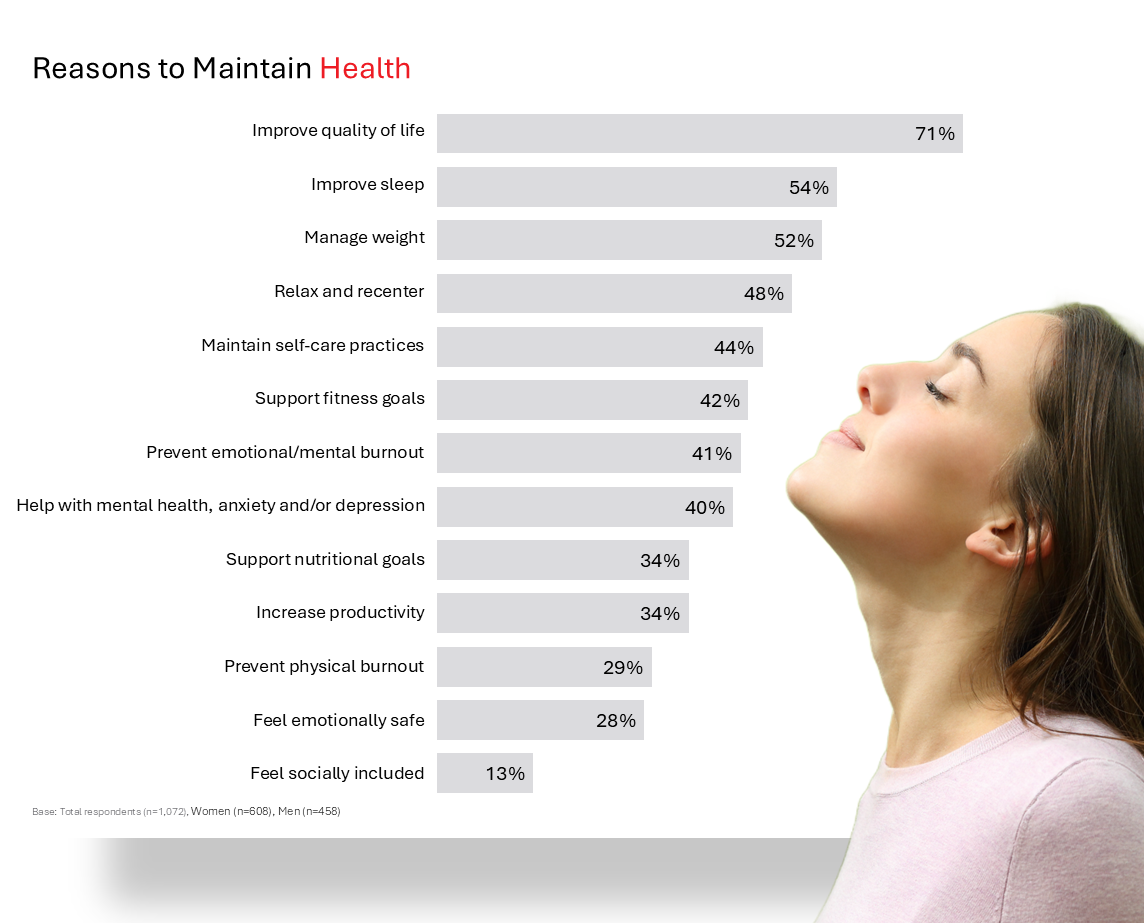The wellness industry is thriving in 2025 due to a growing focus on holistic health, preventative care, and sustainable well-being. People are embracing a comprehensive approach beyond traditional diets and fitness trends. This includes a renewed focus on mental health, emotional well-being, and self-care. The Health and Wellness toolkit helps businesses navigate these changes by providing insights into consumer preferences and emerging wellness trends.
Additionally, remote work and flexible lifestyles have encouraged consumers to invest more in their well-being, fueling demand for wellness tourism, mindfulness practices, and integrative healthcare solutions. To learn more about how health and wellness are also becoming a key factor in travel decisions and other emerging travel trends, read more about our Transformative Travel study.
Due to increasing awareness of the mind-body connection and a shift toward long-term health sustainability, the health and wellness industry continues to expand rapidly. To understand how this evolution impacts the wellness industry and identify consumers’ motivations, resources, and goals for 2025, we surveyed our proprietary U.S. Health and Wellness Community. Discover the full report below.
Core Wellness: The Key Health Areas That Matter Most
Today, consumers are taking a more comprehensive, mind-body approach, recognizing that true well-being encompasses physical, mental, and emotional health, shaping a more balanced perspective on what it means to be healthy.
When asked which aspects of health they prioritize, respondents highlighted a well-rounded approach, with the top 3 areas being:
- 84% prioritize physical health
- 74% focus on mental health
- 71% emphasize emotional well-being
To discover the rest of the health areas to maintain, please consult our Health and Wellness toolkit. For many, wellness is about more than just looking good: it’s a bout feeling good and living well. Here are the reasons to maintain health in 2025, according to respondents:
With the boom of self-care in the United States, women, in particular, are empowered to prioritize their health, self-care, and overall well-being. In fact, women are investing more and more in themselves, recognizing that taking care of their health should not be considered a luxury but a necessity.
In our Health and Wellness Toolkit, we observed many following gender-based differences, such as:
- Women are more likely to focus on weight management (55%) than men (49%).
- 49% of women prioritize self-care, while only 38% of men do.
This suggests that self-care is becoming a more prominent part of women’s wellness routines, while men tend to put less emphasis on these practices. This emphasis on self-care is evident in the plethora of products and practices designed specifically to cater to women’s unique needs, which include the usage of gua sha once a week, drinking immunity ingestibles before consuming coffee, taking daily supplements, consistent journaling, taking pilates classes, and so many more. Whether it’s skincare, nutrition, mindfulness, or movement, these practices are essential to maintaining physical health, mental well-being, and overall balance. (Source: Vogue Beauty, 2025)
The Digital Revolution, Contributing to Tracking Wellness
With the rise of wearable technology and digital health tools, tracking wellness goals has never been easier. In fact, according to our health and wellness online community, 38% use a smartwatch or a bracelet as a resource to maintain their health. Beyond wearables, health and wellness apps also play a key role in their personal health management. Our Health and Wellness Toolkit highlights the most popular tools consumers use to track their progress, which include:
- Fitness tracking apps (33%) help users stay on top of their exercise routines.
- Music apps (19%) keep workouts energized and engaging.
- Meditation and diet tracking apps (13%) support mindfulness and nutrition.
As wearable technology and digital health tools continue to evolve, so do consumer behaviors and expectations. How will the next wave of wearable technology shape personal wellness in 2025?
Stay tuned for our upcoming Wearable Tech Study launching in March, where we’ll dive deeper into the latest trends, consumer preferences and usage.
The Future of Wellness
Health and wellness is no longer one-size-fits-all. With the rise of wearables, fitness apps, and mindful self-care practices, people are embracing personalized, sustainable approaches to well-being. Want to explore the latest health and wellness trends and learn how our experts can help you stay ahead of the curve in this field? Access our full health and wellness report on weight management, fitness communities, and preventative healthcare.




